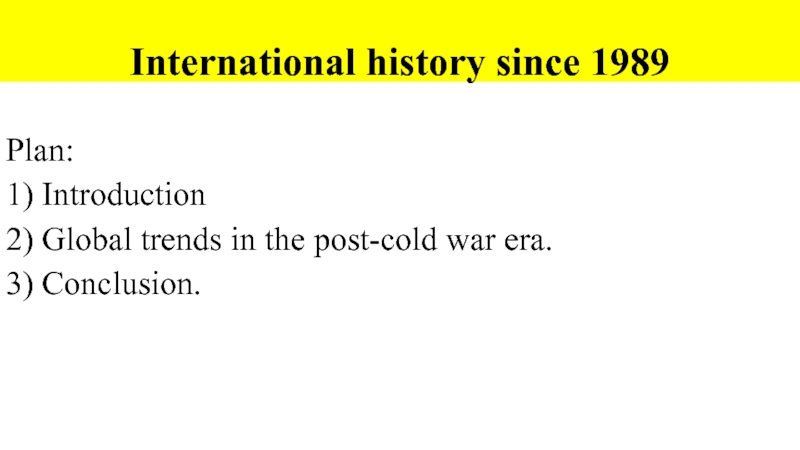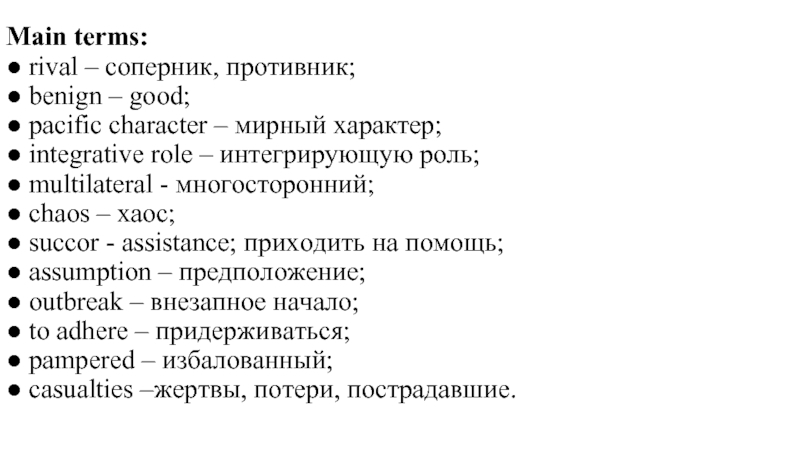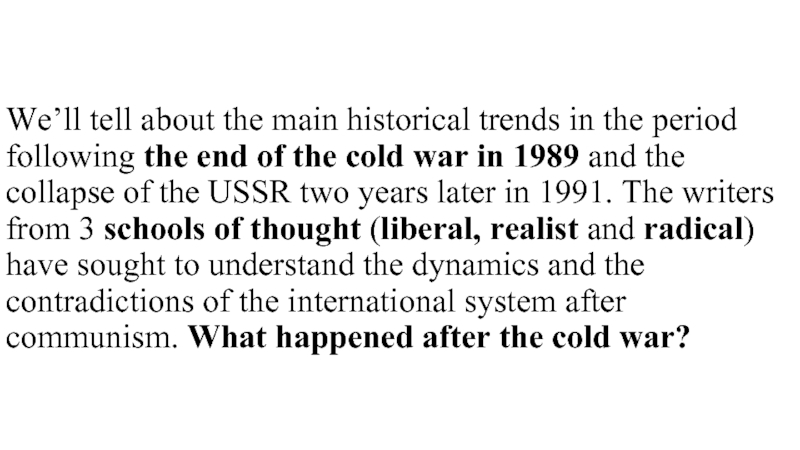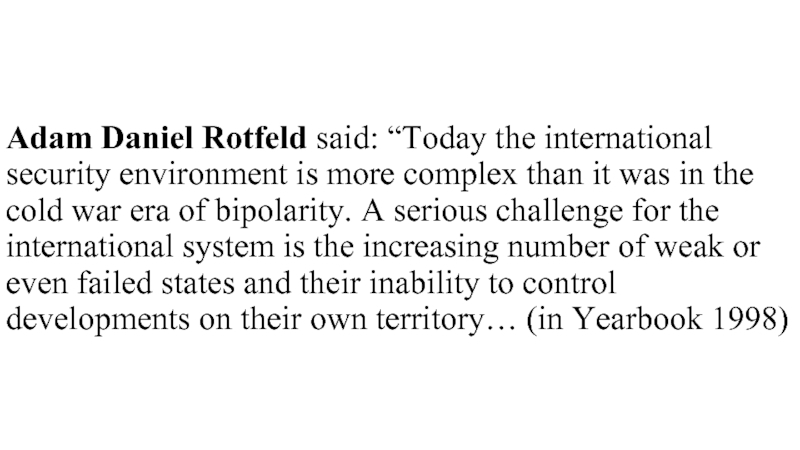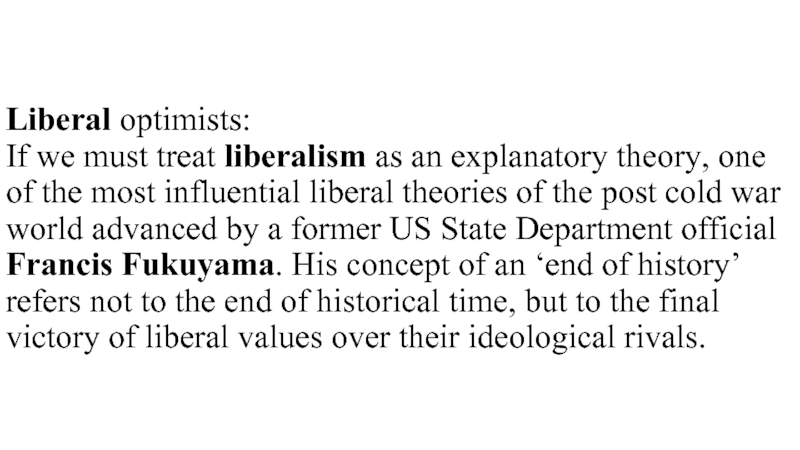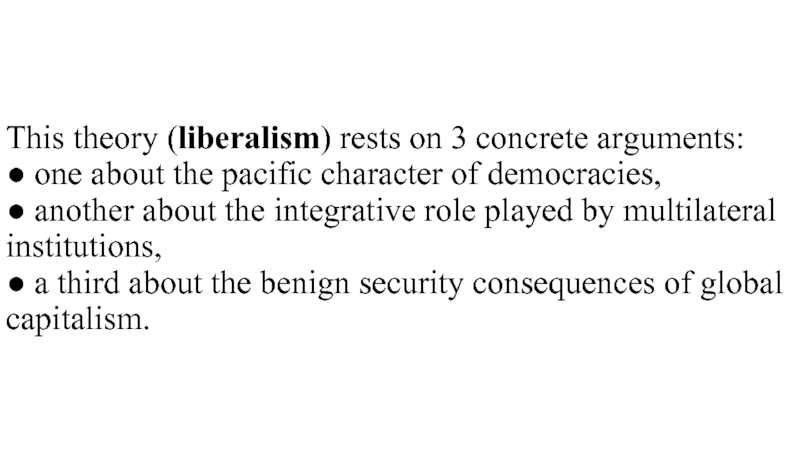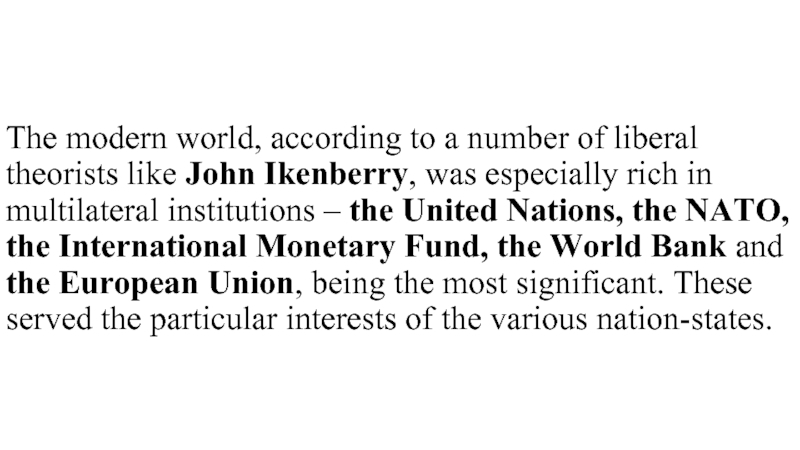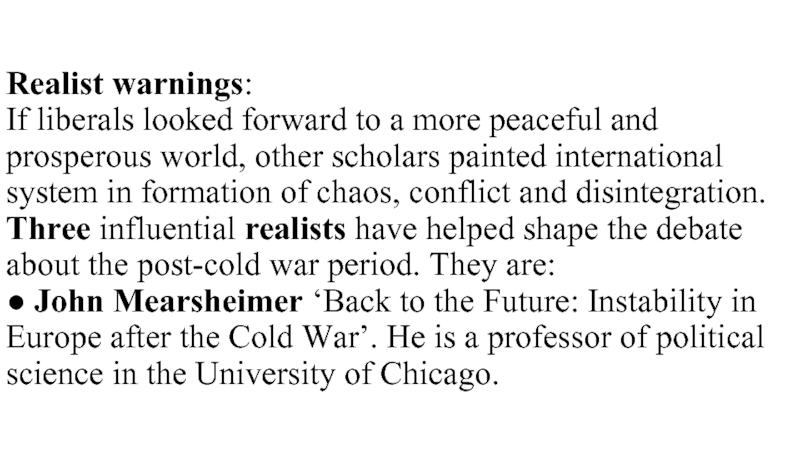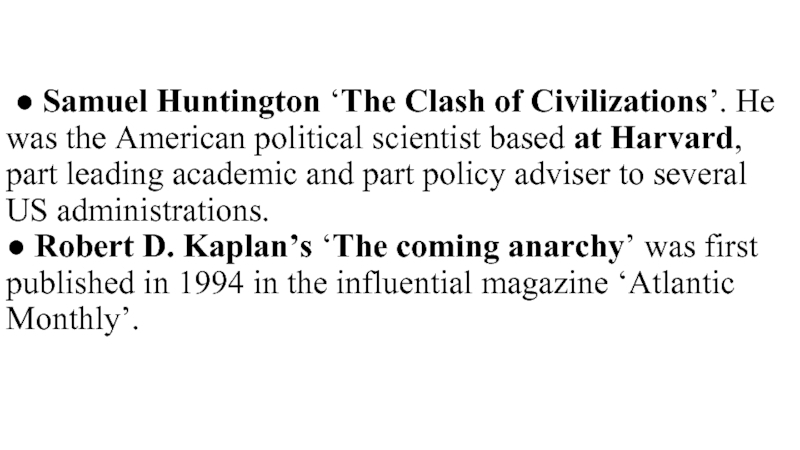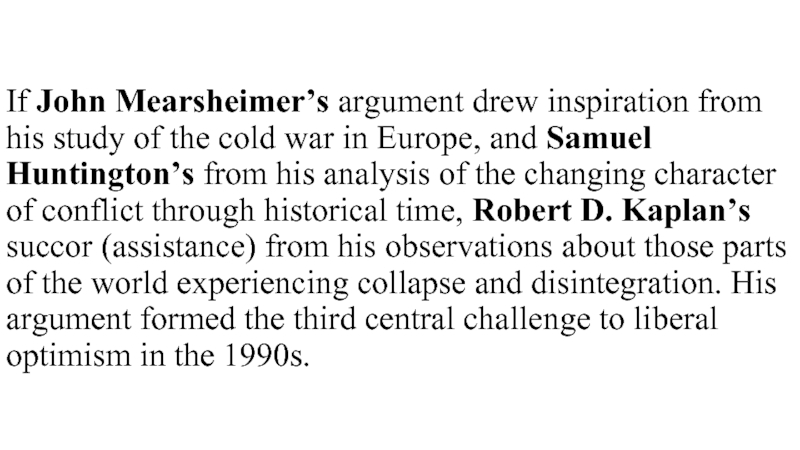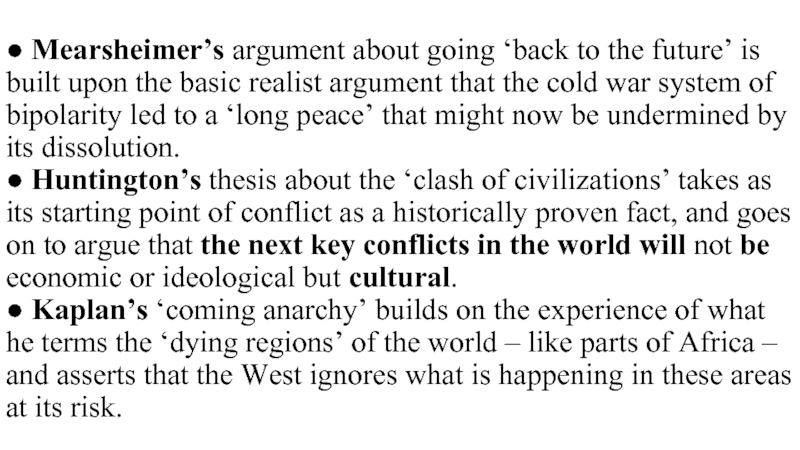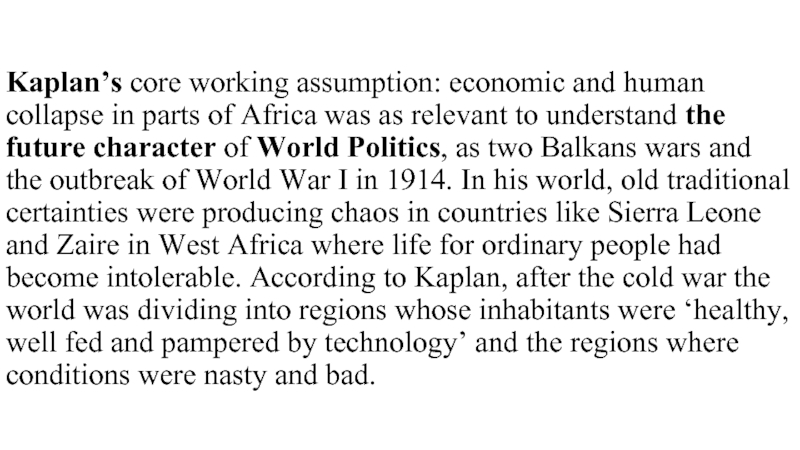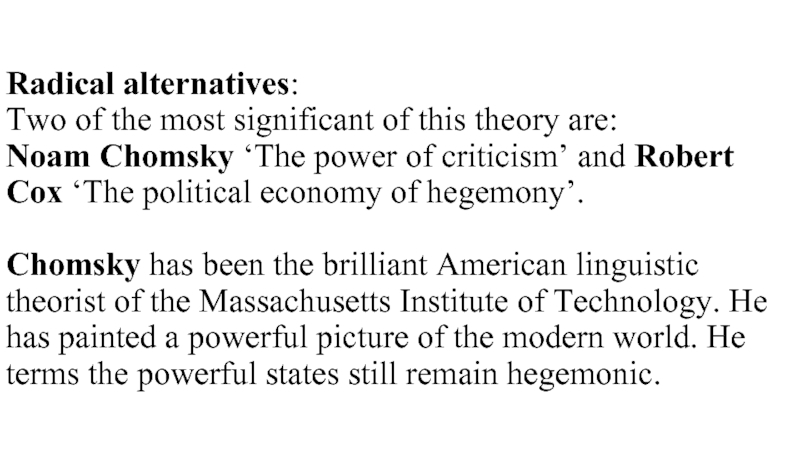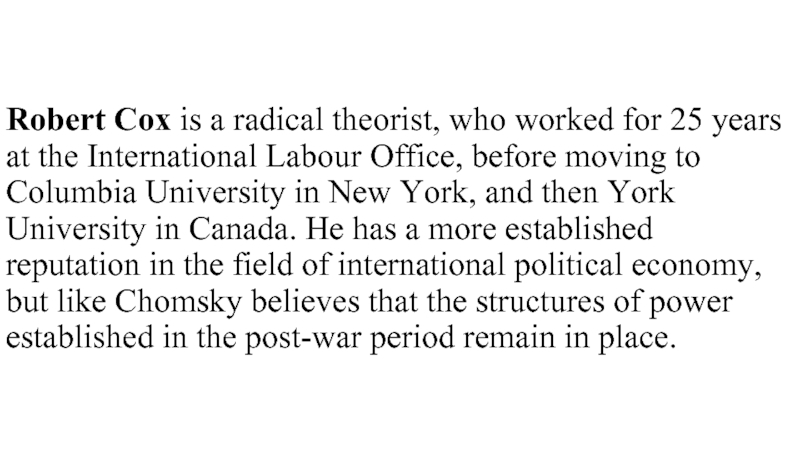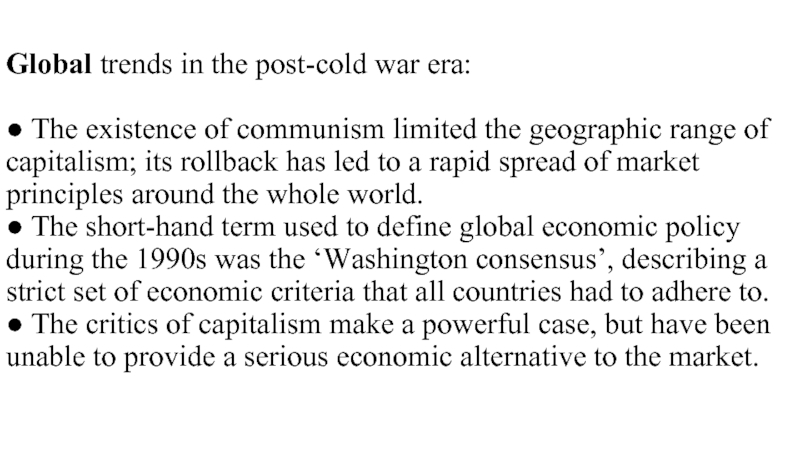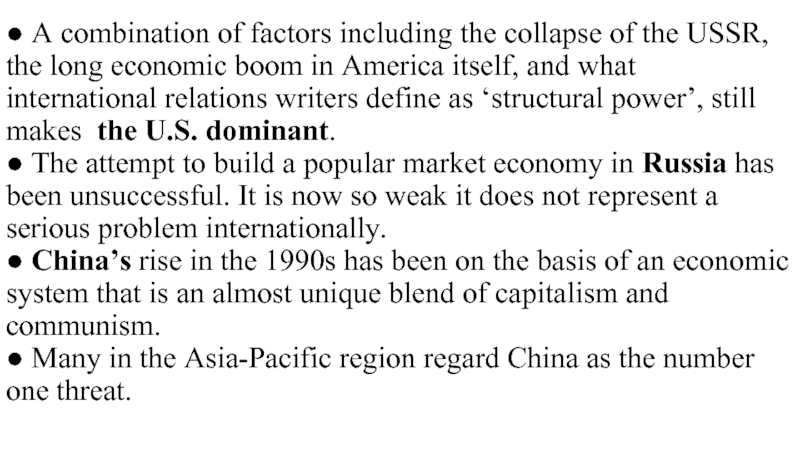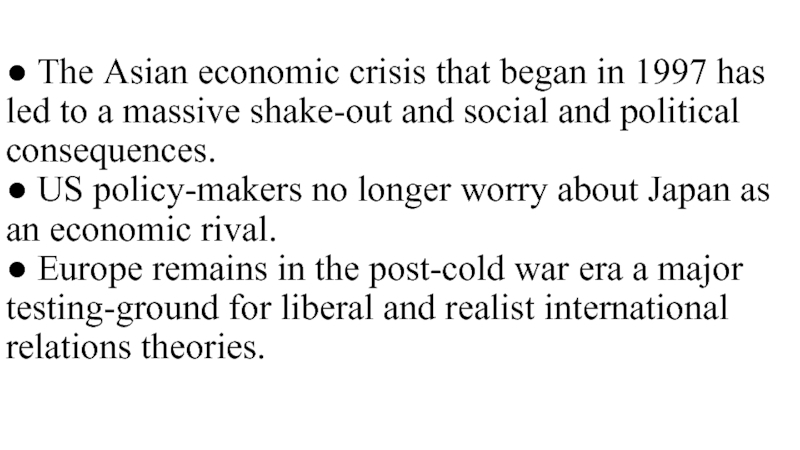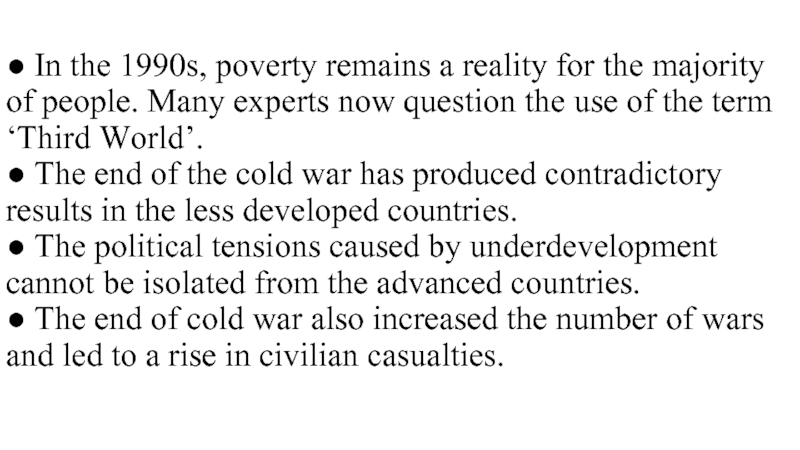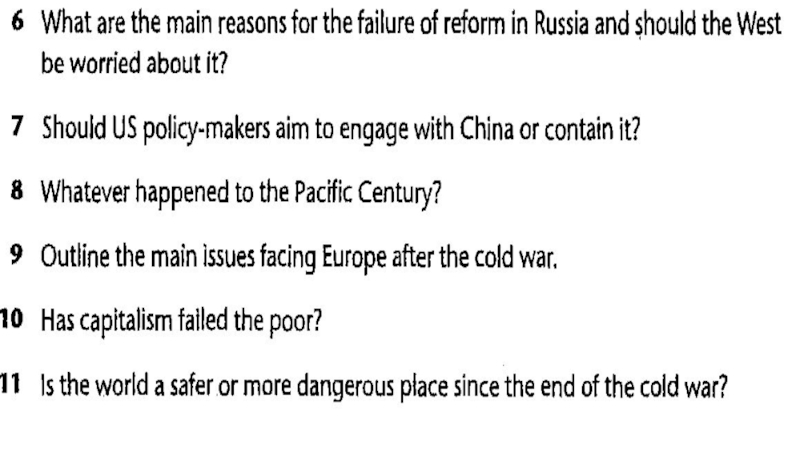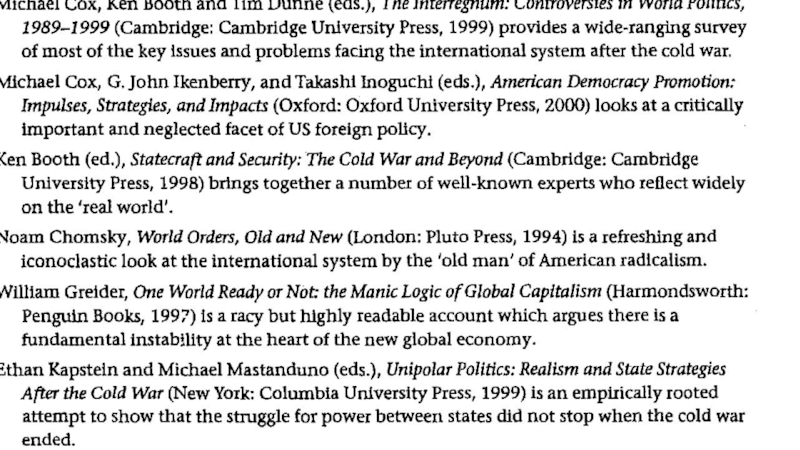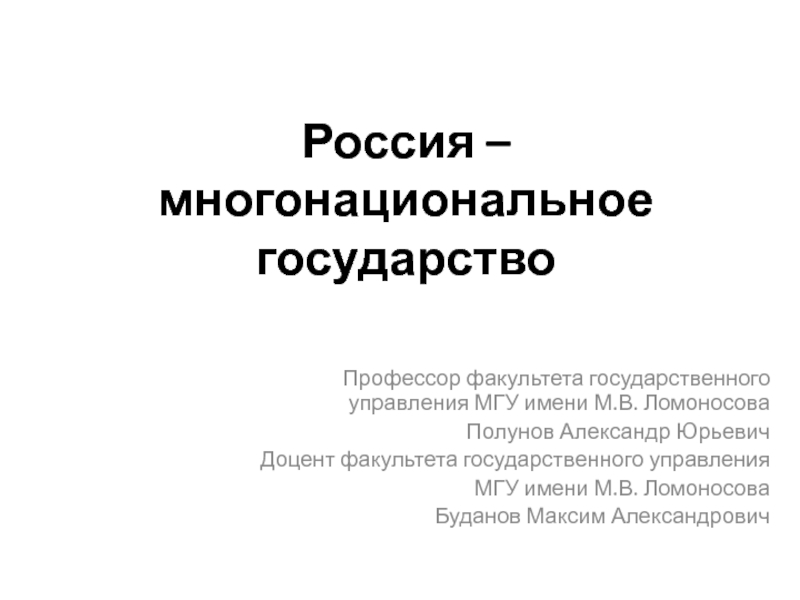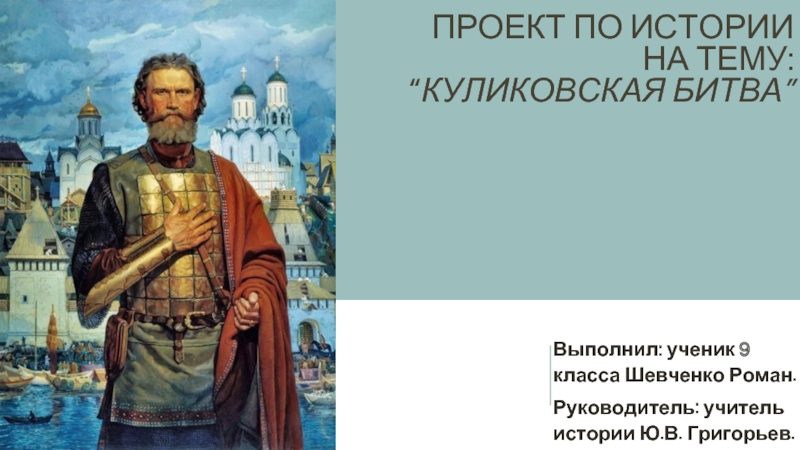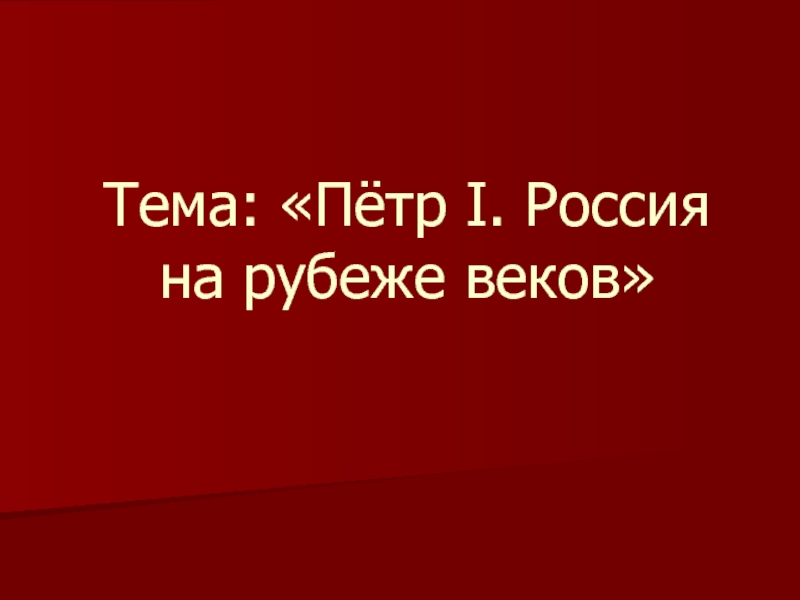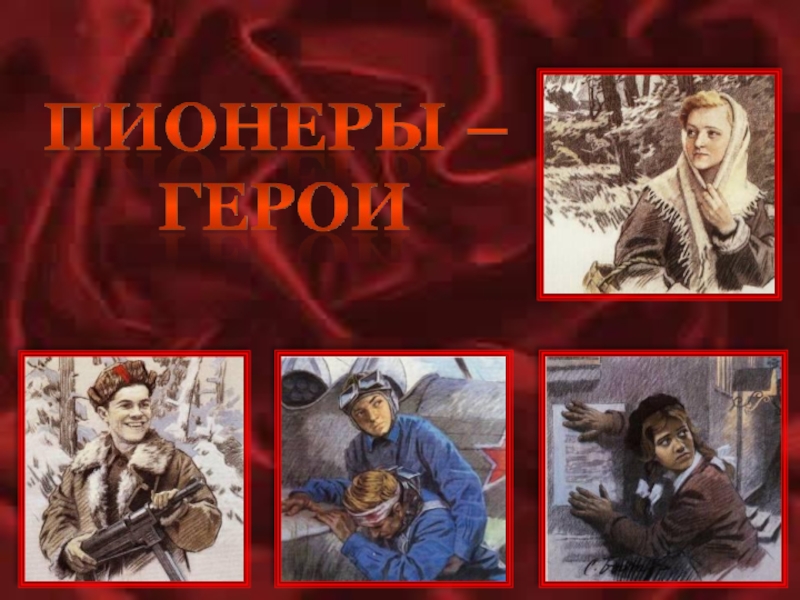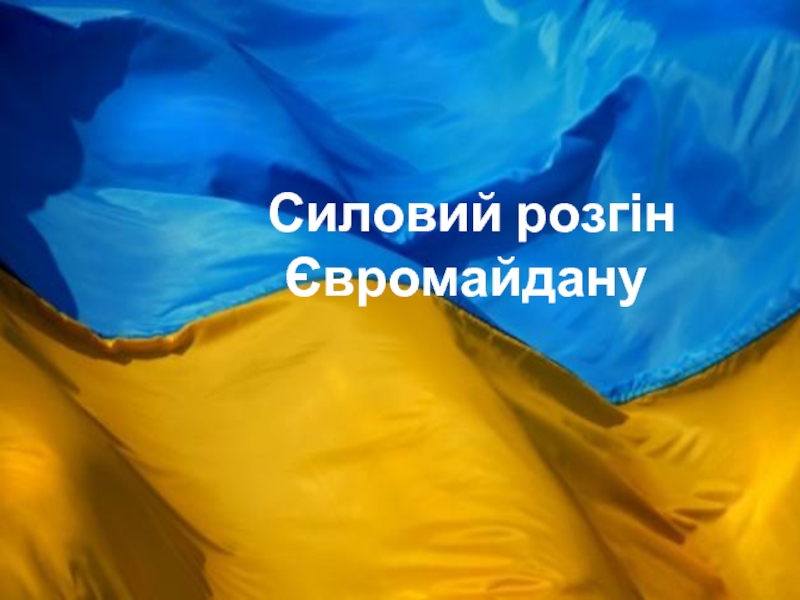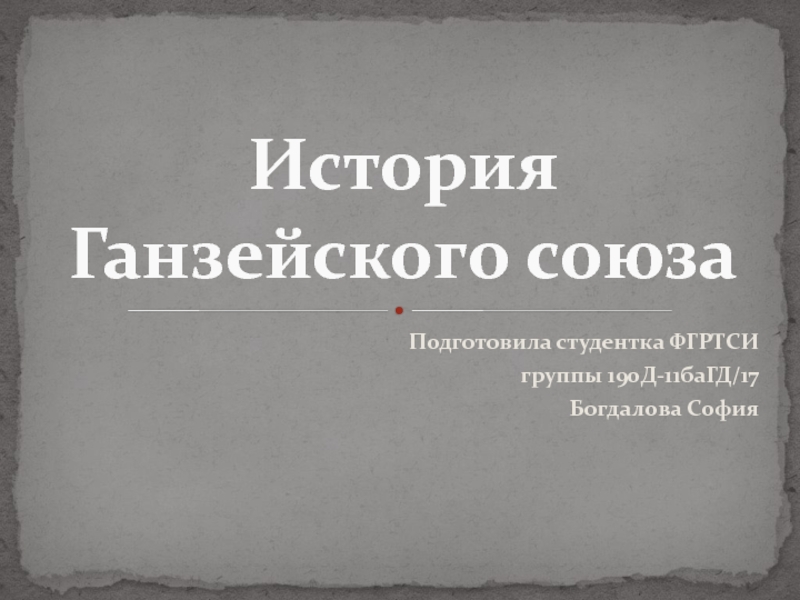era.
3) Conclusion.
- Главная
- Разное
- Дизайн
- Бизнес и предпринимательство
- Аналитика
- Образование
- Развлечения
- Красота и здоровье
- Финансы
- Государство
- Путешествия
- Спорт
- Недвижимость
- Армия
- Графика
- Культурология
- Еда и кулинария
- Лингвистика
- Английский язык
- Астрономия
- Алгебра
- Биология
- География
- Детские презентации
- Информатика
- История
- Литература
- Маркетинг
- Математика
- Медицина
- Менеджмент
- Музыка
- МХК
- Немецкий язык
- ОБЖ
- Обществознание
- Окружающий мир
- Педагогика
- Русский язык
- Технология
- Физика
- Философия
- Химия
- Шаблоны, картинки для презентаций
- Экология
- Экономика
- Юриспруденция
International history since 1989 презентация
Содержание
- 1. International history since 1989
- 2. Main terms: ● rival – соперник, противник;
- 3. We’ll tell about the main historical trends
- 4. They tries to relate these very different
- 5. Adam Daniel Rotfeld said: “Today the international
- 6. Liberal optimists: If we must treat liberalism
- 7. This theory (liberalism) rests on
- 8. The modern world, according to a number
- 9. Realist warnings: If liberals looked forward to
- 10. ● Samuel Huntington ‘The Clash of
- 11. If John Mearsheimer’s argument drew inspiration from
- 12. ● Mearsheimer’s argument about going ‘back to
- 13. Kaplan’s core working assumption: economic and human
- 14. Radical alternatives: Two of the most significant
- 15. Robert Cox is a radical theorist, who
- 16. Global trends in the post-cold war era:
- 17. ● A combination of factors including the
- 18. ● The Asian economic crisis that began
- 19. ● In the 1990s, poverty remains
Слайд 2Main terms: ● rival – соперник, противник; ● benign – good; ● pacific character
– мирный характер;
● integrative role – интегрирующую роль;
● multilateral - многосторонний;
● chaos – хаос;
● succor - assistance; приходить на помощь;
● assumption – предположение;
● outbreak – внезапное начало;
● to adhere – придерживаться;
● pampered – избалованный;
● casualties –жертвы, потери, пострадавшие.
Слайд 3We’ll tell about the main historical trends in the period following
the end of the cold war in 1989 and the collapse of the USSR two years later in 1991. The writers from 3 schools of thought (liberal, realist and radical) have sought to understand the dynamics and the contradictions of the international system after communism. What happened after the cold war?
Слайд 4They tries to relate these very different ‘grand’ theories to the
real world by looking at the following developments:
- the triumph of capitalism as a world organizing principle; - the renewal of US hegemony, the decline of post-communist Russia;
- the rise of China, the Asian-Pacific crisis;
- the limits of European power and the enormous gap that exists between the relatively rich North and the poor South.
Слайд 5Adam Daniel Rotfeld said: “Today the international security environment is more
complex than it was in the cold war era of bipolarity. A serious challenge for the international system is the increasing number of weak or even failed states and their inability to control developments on their own territory… (in Yearbook 1998)
Слайд 6Liberal optimists: If we must treat liberalism as an explanatory theory, one
of the most influential liberal theories of the post cold war world advanced by a former US State Department official Francis Fukuyama. His concept of an ‘end of history’ refers not to the end of historical time, but to the final victory of liberal values over their ideological rivals.
Слайд 7 This theory (liberalism) rests on 3 concrete arguments: ● one about
the pacific character of democracies,
● another about the integrative role played by multilateral institutions,
● a third about the benign security consequences of global capitalism.
Слайд 8The modern world, according to a number of liberal theorists like
John Ikenberry, was especially rich in multilateral institutions – the United Nations, the NATO, the International Monetary Fund, the World Bank and the European Union, being the most significant. These served the particular interests of the various nation-states.
Слайд 9Realist warnings: If liberals looked forward to a more peaceful and prosperous
world, other scholars painted international system in formation of chaos, conflict and disintegration.
Three influential realists have helped shape the debate about the post-cold war period. They are:
● John Mearsheimer ‘Back to the Future: Instability in Europe after the Cold War’. He is a professor of political science in the University of Chicago.
Слайд 10 ● Samuel Huntington ‘The Clash of Civilizations’. He was the
American political scientist based at Harvard, part leading academic and part policy adviser to several US administrations.
● Robert D. Kaplan’s ‘The coming anarchy’ was first published in 1994 in the influential magazine ‘Atlantic Monthly’.
Слайд 11If John Mearsheimer’s argument drew inspiration from his study of the
cold war in Europe, and Samuel Huntington’s from his analysis of the changing character of conflict through historical time, Robert D. Kaplan’s succor (assistance) from his observations about those parts of the world experiencing collapse and disintegration. His argument formed the third central challenge to liberal optimism in the 1990s.
Слайд 12● Mearsheimer’s argument about going ‘back to the future’ is built
upon the basic realist argument that the cold war system of bipolarity led to a ‘long peace’ that might now be undermined by its dissolution.
● Huntington’s thesis about the ‘clash of civilizations’ takes as its starting point of conflict as a historically proven fact, and goes on to argue that the next key conflicts in the world will not be economic or ideological but cultural.
● Kaplan’s ‘coming anarchy’ builds on the experience of what he terms the ‘dying regions’ of the world – like parts of Africa – and asserts that the West ignores what is happening in these areas at its risk.
Слайд 13Kaplan’s core working assumption: economic and human collapse in parts of
Africa was as relevant to understand the future character of World Politics, as two Balkans wars and the outbreak of World War I in 1914. In his world, old traditional certainties were producing chaos in countries like Sierra Leone and Zaire in West Africa where life for ordinary people had become intolerable. According to Kaplan, after the cold war the world was dividing into regions whose inhabitants were ‘healthy, well fed and pampered by technology’ and the regions where conditions were nasty and bad.
Слайд 14Radical alternatives: Two of the most significant of this theory are: Noam Chomsky
‘The power of criticism’ and Robert Cox ‘The political economy of hegemony’.
Chomsky has been the brilliant American linguistic theorist of the Massachusetts Institute of Technology. He has painted a powerful picture of the modern world. He terms the powerful states still remain hegemonic.
Слайд 15Robert Cox is a radical theorist, who worked for 25 years
at the International Labour Office, before moving to Columbia University in New York, and then York University in Canada. He has a more established reputation in the field of international political economy, but like Chomsky believes that the structures of power established in the post-war period remain in place.
Слайд 16Global trends in the post-cold war era: ● The existence of
communism limited the geographic range of capitalism; its rollback has led to a rapid spread of market principles around the whole world.
● The short-hand term used to define global economic policy during the 1990s was the ‘Washington consensus’, describing a strict set of economic criteria that all countries had to adhere to.
● The critics of capitalism make a powerful case, but have been unable to provide a serious economic alternative to the market.
Слайд 17● A combination of factors including the collapse of the USSR,
the long economic boom in America itself, and what international relations writers define as ‘structural power’, still makes the U.S. dominant.
● The attempt to build a popular market economy in Russia has been unsuccessful. It is now so weak it does not represent a serious problem internationally.
● China’s rise in the 1990s has been on the basis of an economic system that is an almost unique blend of capitalism and communism.
● Many in the Asia-Pacific region regard China as the number one threat.
Слайд 18● The Asian economic crisis that began in 1997 has led
to a massive shake-out and social and political consequences.
● US policy-makers no longer worry about Japan as an economic rival.
● Europe remains in the post-cold war era a major testing-ground for liberal and realist international relations theories.
Слайд 19 ● In the 1990s, poverty remains a reality for the majority
of people. Many experts now question the use of the term ‘Third World’.
● The end of the cold war has produced contradictory results in the less developed countries.
● The political tensions caused by underdevelopment cannot be isolated from the advanced countries.
● The end of cold war also increased the number of wars and led to a rise in civilian casualties.
